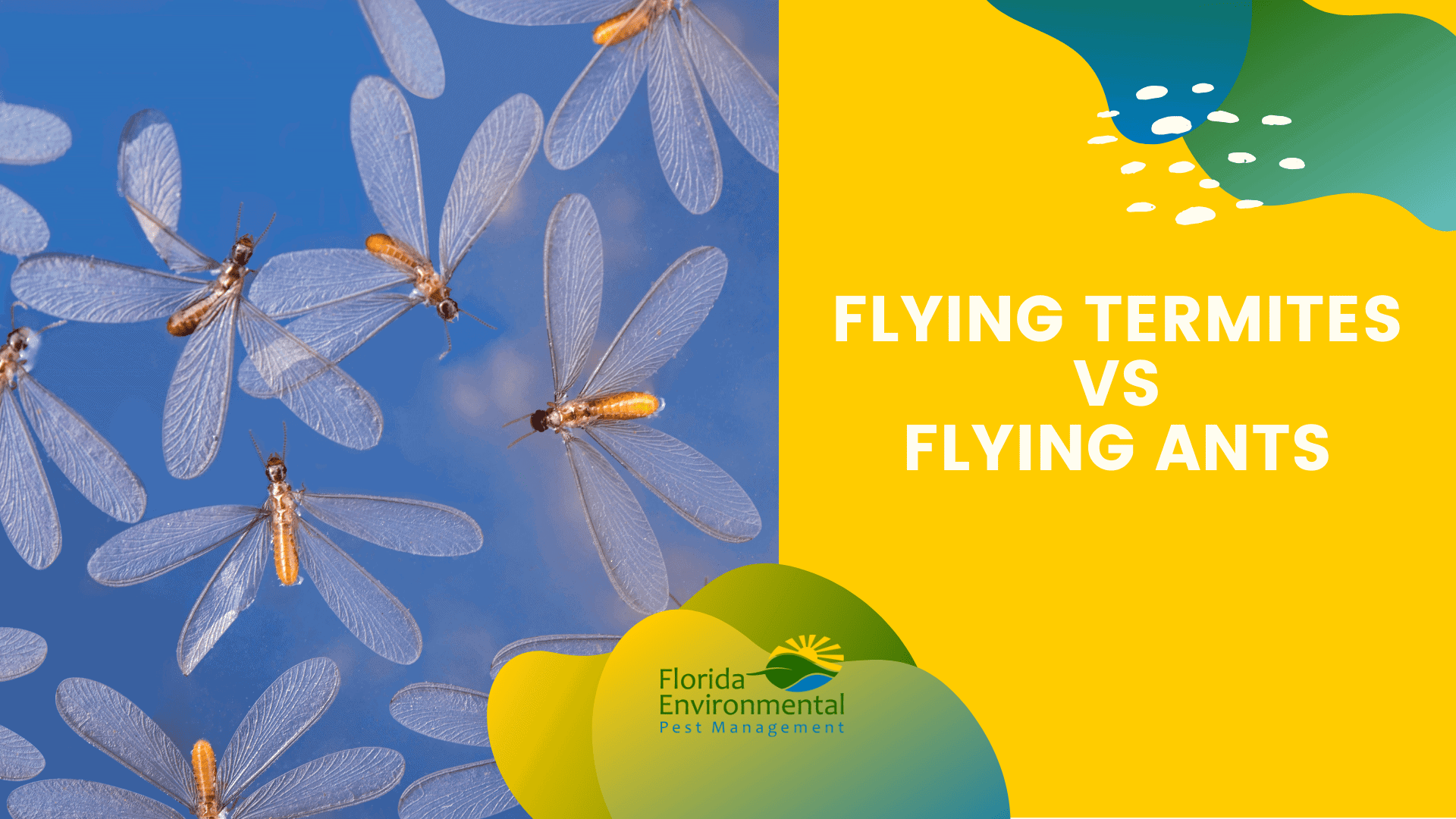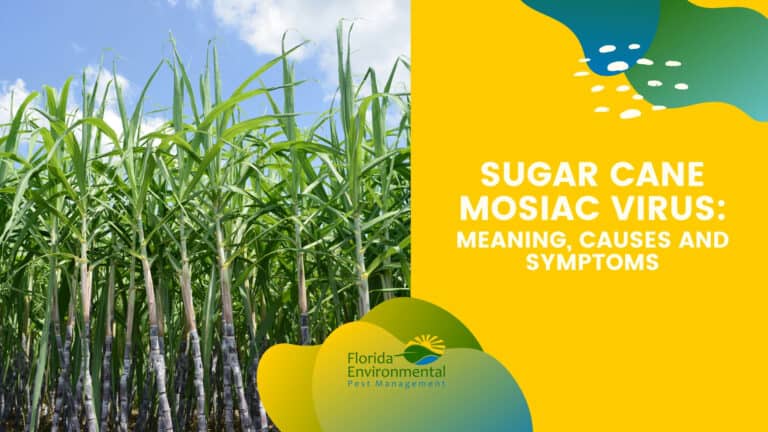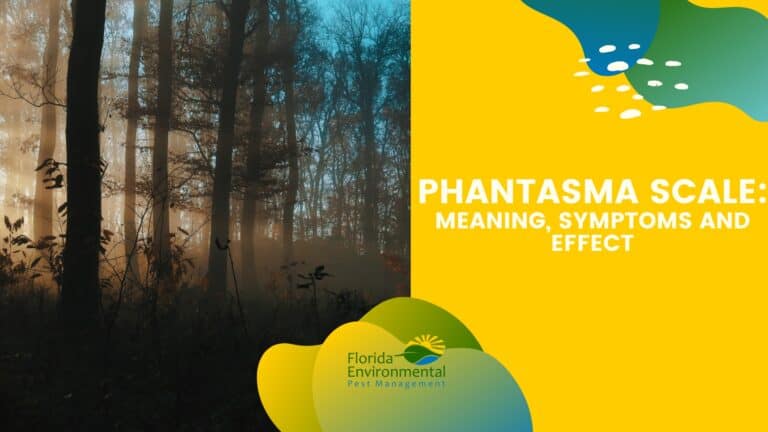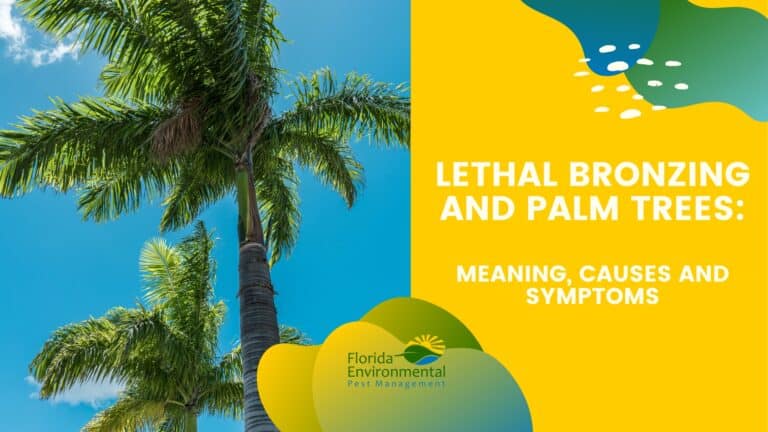Flying termites and flying ants, though often mistaken for each other, exhibit distinct characteristics that set them apart. Understanding these differences is crucial for effective pest control and management.
Termites and ants both have flying reproductive members that emerge due to environmental factors like temperature and humidity. In termites, this marks the beginning of a new colony, while in ants, it’s aimed at establishing new colonies.
Both flying termites and flying ants share the goal of reproduction and establishing new colonies. However, they can be distinguished by their appearance: flying termites have straight antennae, a uniform waist, and equal-length wings while flying ants have elbowed antennae, a constricted waist, and unequal-length wings. These differences are important for identifying them correctly and implementing appropriate pest control measures.
Differences Between Flying Termites and Flying Ants
Distinguishing between flying termites and flying ants is crucial for effective pest control. This table highlights key differences in appearance, habitat, diet, and life cycle, providing a quick reference for identification.
| Differences | Flying Termites | FlyingAnts |
| Appearance Differences | Wings of equal size, straight antennae, broad straight abdomen. | Two pairs of wings with noticeable size difference, bent antennae, thin abdomen, pinched-in waist. |
| Habitat | Swarms triggered by heavy rainfall and warm, humid conditions. | Near moisture, moist wood, dark, damp areas. |
| Diet Differences | Consume decaying plant material, particularly wood. | A diverse diet includes seeds, nectar, food scraps, and other insects. |
| Life Cycle Differences | Swarm to establish new colonies, and leave colonies for reproductive flights. Worker ants have a lifespan of weeks to months, while queens can live for years. | Shorter swarming period. Termites live for a couple of years, with queen termites having the potential to survive for decades. |
1. Appearance Differences
Flying termites can be distinguished by their wings, which are all the same size and longer than their bodies. On the other hand, flying ants have two pairs of wings with noticeable differences in size, featuring longer front wings and smaller hind wings.
Termites exhibit straight antennae, wide bodies without a pinched waist, and are characteristically black or dark brown. In contrast, flying ants have elbowed antennae, and a pinched waist, and their bodies can be black, brown, or reddish.
2. Habitat
The habitat of flying termites involves areas conducive to swarm formation, often triggered by heavy rainfall and warm, humid conditions. These reproductive termites, visible during swarms, leave their colonies to initiate new ones. Swarming activity is particularly associated with rain, and the humid environment facilitates the reproductive process. The habitat plays a crucial role in supporting the life cycle of flying termites, providing optimal conditions for their reproductive flights and the subsequent establishment of new colonies.
Unlike termites, flying ants are often seen openly, swarming during warmer weather.
Their preference for areas with damp conditions is crucial during the reproductive stage, facilitating the establishment of new colonies. The presence of flying ants is commonly observed in locations with suitable moisture levels, and they play a vital role in the life cycle of ant colonies by initiating the process of colony formation in conducive habitats.
Recognizing these habitat distinctions is crucial for accurate identification and effective pest management.
3. Diet Differences
Flying termites and flying ants exhibit distinctive dietary preferences. Ants, being omnivores, primarily consume nectar, seeds, other insects, and food debris in and around homes. In contrast, termites have a cellulose-rich diet, feeding predominantly on wood, paper, and other cellulose-based products. This dietary divergence plays a pivotal role in understanding their ecological roles and potential impact on habitats.
The dietary habits of these insects have significant implications for infestation dynamics, structural damage, and economic impact. Termites pose a considerable threat to wooden structures, causing potential structural damage and necessitating vigilance in monitoring and preventive measures. On the other hand, ants’ omnivorous diet may lead to their presence around various food sources, requiring nuisance control strategies.
Prevention strategies tailored to their dietary inclinations involve addressing environmental factors. For termites, implementing measures to safeguard wooden structures, such as monitoring and utilizing bait stations, is crucial. In the case of ants, focusing on eliminating food sources and fixing moisture issues can aid in effective nuisance control.
4. Life Cycle Differences
Termites and flying ants undergo distinct life cycles. The life cycle of a flying termite begins with the reproductive alates, commonly known as swarmers, emerging from mature colonies during specific seasons. After a synchronized flight, they shed their wings and form new pairs. The mated pairs then seek suitable nesting sites, where the female lays eggs. The eggs hatch into larvae, undergo molting stages, and eventually mature into worker, soldier, or reproductive termites, completing the life cycle within the established colony.
The life cycle of flying ants begins when winged reproductive ants, emerge from colonies for a mating flight. After mating, males die, and females shed their wings. The mated queen establishes a new colony, laying eggs that hatch into larvae. Larvae pupate and develop into worker ants. The queen continues laying eggs, producing new workers, and occasionally, winged reproductives. The cycle repeats, with colonies growing and producing new alates for future mating flights.
Worker ants live for weeks to months, and queens for years. In contrast, most termites survive a couple of years, with termite queens potentially living for decades. Recognizing these distinctions is crucial for effective pest control and understanding their roles in ecosystems.
How to Identify and Prevent Flying Ants Infestation and Flying Termite Infestation?
Identification and Prevention of Flying Ants
Here’s how to identify and prevent a flying ant infestation:
Identification:
- Look for winged ants in your home or yard.
- Flying ants are usually larger than regular ants and have two sets of wings, with the front pair being larger than the hind pair.
- Wings are usually clear or slightly brownish in color.
- Swarmers have a small, narrow-waisted body and a pair of elbowed antennae.
Prevention:
Seal any cracks, gaps, or holes in your home’s exterior to prevent ants from entering. Keep your home clean and free of food debris, as ants are attracted to food sources.
Trim tree branches and shrubs that may be touching your home, as ants may use these as bridges to enter your home. Regularly inspect your home for signs of ant infestations and address them promptly. Use ant baits or traps to eliminate the ants and their colonies.
Identification and Prevention of Flying Termites:
Here’s how to identify and prevent a flying termite infestation:
Identification:
- Look for winged termites in your home or yard.
- Flying termites are usually dark-bodied with straight, beaded antennae and two sets of wings, with both pairs being equal in size and length.
- Swarmers have a thick, straight body with a slight narrowing towards the abdomen.
- Wings are usually clear or slightly brownish in color.
Prevention:
Eliminate moisture problems in your home, as termites are attracted to damp areas. Keep woodpiles, firewood, and other cellulose-based materials away from your home’s foundation.
Seal any cracks, gaps, or holes in your home’s exterior to prevent termites from entering. Regularly inspect your home for signs of termite infestations and address them promptly.
Use termite baits or traps to eliminate the termites and their colonies. If you are unsure about the type of infestation you are dealing with, it is always best to consult a professional exterminator for proper identification and treatment.
How to Get Rid of Flying Termites and Flying Ants?
How to Get Rid of Flying Termites?
To get rid of flying termites, professional termite removal methods are often recommended. One effective approach is the application of liquid Termidor by local termite removal companies. Home remedies may include using neem oil, known for its termite-repelling properties. However, for comprehensive and lasting results, seeking professional assistance and implementing preventive measures are crucial to ensure the complete removal of flying termites from your property.
To eliminate flying termites:
- Maintain a clutter-free, dry, and well-ventilated property.
- Address plumbing issues promptly.
- Practice regular home cleaning to eliminate attractants.
- Install window and door net screens to prevent entry.
- Consider professional anti-termite treatments for effective control.
Understanding the biology and behavior of flying termites, along with implementing these measures, is crucial for protecting homes from potential damage. It’s important to act promptly to avoid the establishment of termite colonies, which can pose threats to wooden structures and plants, disrupting ecosystems.
Regular inspection and a combination of curative and preventive methods, including professional intervention, contribute to comprehensive termite control.
How to Get Rid of Flying Ants?
To get rid of flying ants, effective ant removal methods are recommended. Utilizing ant baits or insecticidal sprays specifically designed for ant control can help eliminate flying ants. Identifying and sealing entry points, such as cracks and crevices, is crucial to prevent their access.
To eliminate flying ants:
- Use a vacuum to remove visible swarms, replacing the bag immediately.
- Locate and destroy colonies by following ant trails and pouring boiling water into their nests.
- Seal potential entry points, such as cracks in walls and windows, using caulk to prevent re-infestation.
- Implement preventive measures like eliminating food sources, storing items in airtight containers, and addressing leaks to make your home less attractive to flying ants.
- If the infestation persists or you can’t locate the colony, consider professional pest control services.
- Understand that flying ants, though alarming, are not dangerous, and knowing their reproductive cycle and habits is crucial for effective control.
While maintaining a clean environment, especially food storage areas, discourages ant infestations. Seeking professional pest control services may provide tailored solutions for comprehensive flying ant removal.
Should I Be Worried About Flying Termites?
Yes, you should be worried about flying termites. Flying termites can cause significant damage to homes by initiating new colonies, leading to potential structural harm. Their presence may indicate an existing termite problem or the risk of one, requiring prompt attention to prevent further damage.
What Attracts Flying Termites?
Flying termites are attracted to light sources, particularly during their swarming season in spring or summer. They may be drawn to various light fixtures, including porch lamps, motion lights, and indoor lights, causing them to swarm around these areas.
How Do You Find out Where Flying Ants Are Coming From?
To find where flying ants are coming from, observe their flight patterns, inspect possible entry points, check outdoor areas, follow ant trails, look for signs of nests, address moisture issues, and consider professional help if needed. Understanding their behavior and reproductive cycle is essential for locating their source.
Where Do Flying Ants Live in Your House?
Flying ants can be found in various locations within your house, and their choice of nesting sites depends on their species and environmental factors. Here are common areas where flying ants may live in your house:
- Walls and Voids: Flying ants may establish nests inside the walls and voids of your house. These spaces provide a concealed environment for them to build colonies and reproduce.
- Underground Nests: Some ant species prefer nesting underground. If there are access points in or around your home, flying ants may create nests beneath the soil, especially near pipes or drains.
- Wooden Structures: Certain species of ants, such as carpenter ants, are attracted to wood. They may nest in wooden structures, including beams, joists, or other timber elements of your house.
- Moisture-Prone Areas: Flying ants are drawn to moisture, so areas with water leaks or high humidity levels can be attractive nesting sites. Check for damp conditions in basements, crawl spaces, or around plumbing.
- Cavities and Crevices: Small cavities and crevices in and around your house provide suitable spaces for flying ants to build nests. These locations offer protection and warmth for colony development.
- Near Food Sources: Ants are scavengers, and they may nest near food sources. Kitchens and pantries are common areas, especially if there are crumbs, spills, or open food containers.
- Warm and Dark Areas: Flying ants often prefer warm and dark environments. Attics, basements, and utility rooms may be chosen as nesting sites due to these conditions.
- Exterior Walls: Flying ants may be found on exterior walls, especially during their nuptial flight when they are seeking mates and new nesting locations.
It’s important to note that the specific locations where flying ants choose to live can vary, and identifying their nesting sites may require careful observation. Regular inspections, addressing moisture issues, and keeping your living space clean can help prevent and manage flying ant infestations. If the infestation persists, seeking professional pest control assistance is recommended for effective eradication and prevention measures.





